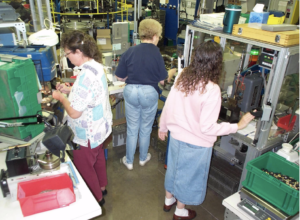The concept of a Cellular Manufacturing applies to processes involving machines as well as to manual assembly, with improvement opportunities of the same magnitude but different challenges. Cellular Manufacturing is a set of collocated, physically linked machines performing a common sequence of process steps for a family of items and run by a team of multi skilled operators that controls the release of work to the first step in the sequence. Unlike manual assembly, the work done by machines cannot be rebalanced at will, and the cell’s capacity is limited by that of its bottleneck. 100% utilization of all the machines in a cell is usually impossible, and utilization metrics in this case are more relevant for the cell as a whole than for the machines in it. Cell layouts aim to facilitate the flow of workpieces and the movements of operators while providing the required clearances for maintenance access to the machines. As a result, machines are closely packed and at crooked angles to one another, as opposed the traditional, facilities-driven neat rows.
Cellular Manufacturing with machines can be defined as:
Collocated machines. A set of collocated, physically linked machines. A common sequence of process steps performed on these machines for a family of parts
Team of multi skilled operators. A team of multifunction operators circulating between and attending to all the machines, moving, and keeping records.
Autonomous pacing. The team controls the release of work to the first step in the sequence.
Essential features of any manufacturing cell are as follows:
Materials flows: Product units move through a sequence of steps without backtracking or iterations.
Production operators are surrounded by machines. The product units flow around the operator work area, without ever crossing it. Each operator usually attends to more than one machine, and these machines are of different types.
Product size: Products up to a particular size only can be produced inside the cells. Large products are very difficult produce in cells and generally produced on moving lines
Number of operations: The cells in the example perform a handful of operations. Provided each operator performs multiple operations, the concept can be stretched to 20 distinct operations, but not 50 or 100.
Number of operators. The examples have no more than three operators working in a cell. There can be more, but that is rare at least in pure machining or fabrication cells. Where some assembly is involved, there can be as many as eight, or even ten, but a production line with 50 operators is definitely not a cell.
Station layout: The machines are laid out so that the operator workstations of successive machines are as close as possible, and this design goal overrides almost every other consideration.
Density: Machines in cells are much more closely packed than in the classical layouts. Even after allowing for maintenance access from the back of the machines, the conversion of a machine shop into cells typically frees up 30% of the floor space

